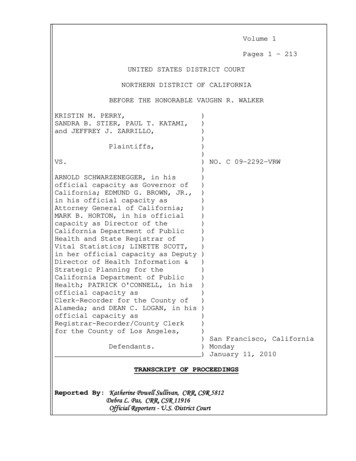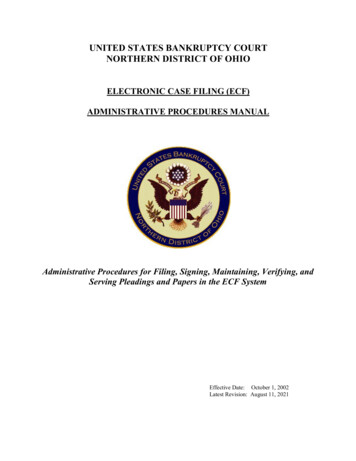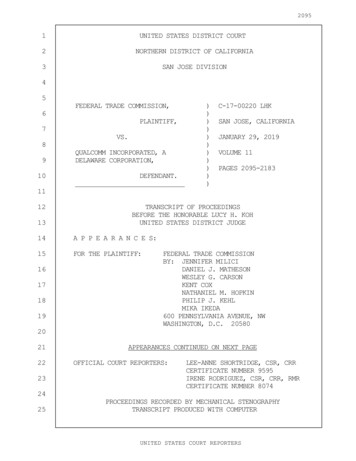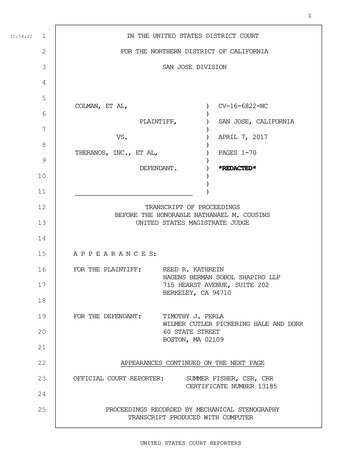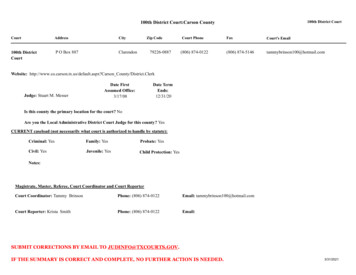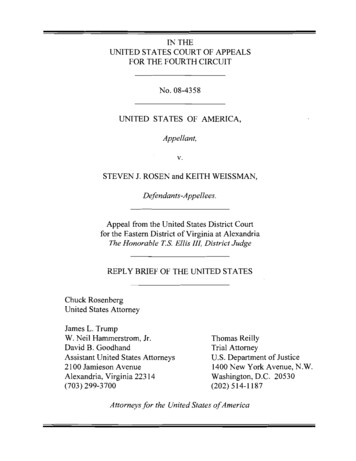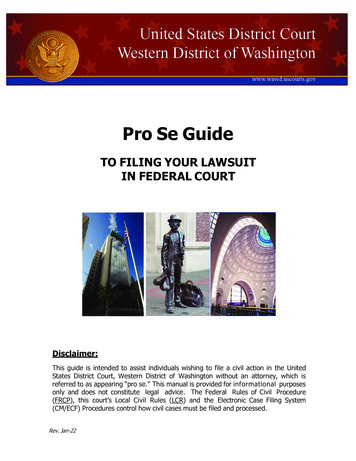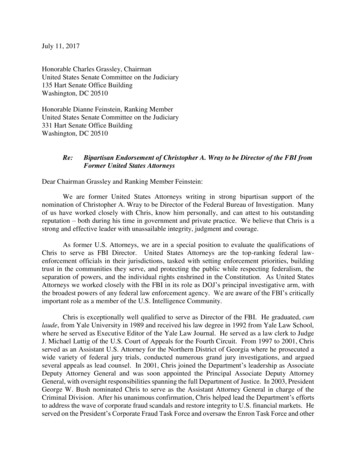
Transcription
UNITED STATES DISTRICT COURTWESTERN DISTRICT OF TEXASPLAINTIFF, on behalf of itself and allothers similarly situated,Plaintiff,Case No.CLASS ACTIONv.SOLARWINDS CORPORATION, KEVINB. THOMPSON, and J. BARTON KALSU,COMPLAINT FOR VIOLATIONS OFTHE FEDERAL SECURITIES LAWSJURY TRIAL DEMANDEDDefendants.Plaintiff, by and through its counsel, alleges the following upon information and belief,except as to those allegations concerning Plaintiff, which are alleged upon personal knowledge.Plaintiff’s information and belief are based upon, inter alia, counsel’s investigation, whichincluded review and analysis of: (a) regulatory filings made by SolarWinds Corporation(“SolarWinds” or the “Company”) with the United States Securities and Exchange Commission(“SEC”); (b) press releases, presentations, and media reports issued and disseminated by theCompany; (c) analyst and media reports concerning SolarWinds; and (d) other public informationregarding the Company.INTRODUCTION1.This securities class action is brought on behalf of all persons or entities thatpurchased or otherwise acquired shares of SolarWinds common stock between October 18, 2018and December 17, 2020, inclusive (the “Class Period”). The claims asserted herein are allegedagainst SolarWinds and certain of the Company’s current and former senior executives
(collectively, “Defendants”), and arise under Sections 10(b) and 20(a) of the Securities ExchangeAct of 1934 (the “Exchange Act”) and Rule 10b-5, promulgated thereunder.2.Headquartered in Austin, Texas, SolarWinds provides software products used tomonitor the health and performance of information technology networks. The Company’s mostimportant product line is its Orion platform, which provides a suite of software tools that provideoversight of network, application, and storage resources.3.Throughout the Class Period, SolarWinds touted its robust security controls andcommitment to prioritizing customers’ security and privacy concerns.The Company alsorepresented that it faced purported risks with regard to its cybersecurity measures. These andsimilar statements made during the Class Period were false and misleading.In reality, theCompany failed to employ adequate cybersecurity safeguards and did not maintain effectivemonitoring systems to detect and neutralize security breaches. As a result of vulnerabilities in theCompany’s cybersecurity protections, which were known to Defendants, SolarWinds and itscustomers were particularly susceptible to cyber-attacks.As a result of Defendants’misrepresentations, shares of SolarWinds common stock traded at artificially inflated pricesthroughout the Class Period.4.The truth began to emerge through a series of disclosures beginning on December13, 2020, when Reuters reported that hackers had infiltrated the networks of the U.S. Treasury andCommerce departments and had been monitoring the agencies’ internal email communications.The report further revealed that the hackers had gained access to the networks by tampering withsoftware updates released by SolarWinds.5.The following day, SolarWinds admitted that hackers had breached its network andinserted malware into software updates for its Orion monitoring products. SolarWinds further2
disclosed that the networks of as many as 18,000 customers may have been compromised by themaliciously coded Orion updates. As a result of these disclosures, the price of SolarWinds stockdeclined nearly 17%, from 23.55 per share to 19.62 per share.6.On December 15, 2020, Reuters reported that a security researcher had warnedSolarWinds in 2019 that anyone could access the Company’s update server by simply using thepassword “solarwinds123.” Thus, according to the researcher, the SolarWinds breach “could havebeen done by any attacker, easily.” Additionally, according to another cybersecurity expert, themalicious Orion updates were still available for download days after the Company had admittedthat its software had been compromised. These disclosures caused the price of SolarWinds stockto decline by nearly 8%, from 19.62 per share to 18.06 per share.7.On December 17, 2020, Bloomberg News reported that at least three stategovernments had been hacked as part of the SolarWinds breach. Moreover, the hackers used theSolarWinds intrusion to infiltrate government networks that implicated national security concerns,including the U.S. Department of Energy and its National Nuclear Security Administration, whichmaintains the country’s arsenal of nuclear weapons. As a result of these disclosures, the price ofSolarWinds stock declined by more than 19%, from 17.60 per share to 14.18 per share.JURISDICTION AND VENUE8.The claims alleged herein arise under Sections 10(b) and 20(a) of the Exchange Act(15 U.S.C. §§ 78j(b) and 78t(a)), and Rule 10b-5 promulgated thereunder (17 C.F.R. § 240.10b5). This Court has jurisdiction over the subject matter of this action pursuant to Section 27 of theExchange Act (15 U.S.C. § 78aa) and 28 U.S.C. § 1331.9.Venue is proper in this District pursuant to Section 27 of the Exchange Act (15U.S.C. § 78aa) and 28 U.S.C. § 1391(b). SolarWinds maintains its headquarters in Austin, Texas,which is situated in this District, conducts substantial business in this District, and many of the3
acts and conduct that constitute the violations of law complained of herein, includingdissemination to the public of materially false and misleading information, occurred in and/or wereissued from this District. In connection with the acts alleged in this Complaint, Defendants,directly or indirectly, used the means and instrumentalities of interstate commerce, including, butnot limited to, the mails, interstate telephone communications, and the facilities of the nationalsecurities markets.PARTIESA.Plaintiff10.Plaintiff purchased SolarWinds common stock at artificially inflated prices duringthe Class Period and suffered damages as a result of the violations of the federal securities lawsalleged herein.B.Defendants11.Defendant SolarWinds is incorporated in Delaware and maintains its corporateheadquarters at 7171 Southwest Parkway, Building 400, Austin, Texas. The Company’s commonstock trades on the New York Stock Exchange (“NYSE”) under ticker symbol “SWI.” As ofOctober 30, 2020, SolarWinds had over 314 million shares of common stock outstanding, ownedby hundreds or thousands of investors.12.Defendant Kevin B. Thompson (“Thompson”) served as President of SolarWindsfrom January 2009 until December 31, 2020.Thompson also served as SolarWinds’ ChiefExecutive Officer and as a member of the Company’s Board of Directors from March 2010 untilDecember 31, 2020.13.Defendant J. Barton Kalsu (“Kalsu”) has served as Executive Vice President, Chief4
Financial Officer, and Treasurer of SolarWinds since April 2016.14.Defendants Thompson and Kalsu are collectively referred to hereinafter as the“Individual Defendants.” The Individual Defendants, because of their positions with SolarWinds,possessed the power and authority to control the contents of the Company’s reports to the SECand other public statements made by SolarWinds during the Class Period. Each of the IndividualDefendants was provided with or had unlimited access to copies of the Company’s reports or otherstatements alleged herein to be misleading prior to, or shortly after, their issuance and had theability and opportunity to prevent their issuance or cause them to be corrected. Because of theirpositions and access to material non-public information available to them, each of the IndividualDefendants knew that the adverse facts specified herein had not been disclosed to, and were beingconcealed from, the public, and that the positive representations which were being made were thenmaterially false and/or misleading.BACKGROUND15.SolarWinds provides infrastructure management software used to monitor andmanage networks, systems, and applications, serving over 300,000 customers worldwide. TheCompany’s flagship product is its Orion platform. Orion provides a suite of software productswidely used by government agencies and Fortune 500 companies to monitor the health andperformance of their information technology networks. The Orion platform accounts for nearlyhalf of the Company’s annual revenue.16.For Orion to function properly, its users must provide SolarWinds with unrestrictedaccess to the contents of their networks, including sensitive administration credentials.Thegranting of such privileges introduces an enormous cybersecurity risk for which it is incumbent onSolarWinds to employ adequate defenses to mitigate. Therefore, SolarWinds’ implementation andmaintenance of strong cybersecurity safeguards was critically important to the Company’s5
business and its customers.DEFENDANTS’ MATERIALLY FALSE AND MISLEADINGSTATEMENTS CAUSE SUBSTANTIAL LOSSES TO INVESTORS17.The Class Period begins on October 18, 2018, when the SEC declared SolarWinds’registration statement for its initial public offering (the “IPO”) effective (the “IPO RegistrationStatement”). On or around October 19, 2018, SolarWinds conducted an IPO pursuant to the IPORegistration Statement. On October 22, 2018, SolarWinds filed a prospectus for the IPO with theSEC on Form 424B4 (the “IPO Prospectus”), which incorporated and formed part of the IPORegistration Statement (collectively, the “IPO Offering Materials”).18.In the IPO Offering Materials, Defendants represented that the Company facedostensible risks regarding the Company’s purported cybersecurity measures.In particular,Defendants represented that “[b]ecause the techniques used to obtain unauthorized access or tosabotage systems change frequently and generally are not identified until they are launched againsta target, we may be unable to anticipate these techniques or to implement adequate preventativemeasures.” Defendants further stated that “[w]e may also experience security breaches that mayremain undetected for an extended period and, therefore, have a greater impact on the products weoffer, the proprietary data contained therein, and ultimately on our business.” Defendants alsostated that these “security problems could result in, among other consequences, damage to our ownsystems or our customers’ [information technology] infrastructure or the loss or theft of ourcustomers’ proprietary or other sensitive information.”Defendants further represented that“[d]espite our security measures, unauthorized access to, or security breaches of, our software orsystems could result in the loss, compromise or corruption of data, loss of business, severereputational damage adversely affecting customer or investor confidence, regulatory investigationsand orders, litigation, indemnity obligations, damages for contract breach, penalties for violation6
of applicable laws or regulations, significant costs for remediation and other liabilities.”Inaddition, Defendants represented that SolarWinds has “incurred and expect[s] to incur significantexpenses to prevent security breaches, including deploying additional personnel and protectiontechnologies, training employees, and engaging third-party experts and consultants.”19.On November 27, 2018, SolarWinds filed with the SEC a Form 10-Q for the thirdquarter of 2018.The 10-Q was signed by Defendant Kalsu and contained certifications byDefendants Thompson and Kalsu attesting to the purported accuracy and completeness of the 10Q. The 10-Q incorporated by reference the Company’s representations regarding its cybersecurityrisks contained in the IPO Prospectus, as set forth in ¶18.20.On February 25, 2019, SolarWinds filed with the SEC a Form 10-K for the fiscalyear ended December 31, 2018 (the “2018 10-K”). The 2018 10-K was signed by DefendantsThompson and Kalsu and contained certifications by them attesting to the purported accuracy andcompleteness of the 2018 10-K. In the 2018 10-K, Defendants represented that the Company facedostensible risks regarding the Company’s purported cybersecurity measures.In particular,Defendants represented that “[b]ecause the techniques used to obtain unauthorized access or tosabotage systems change frequently and generally are not identified until they are launched againsta target, we may be unable to anticipate these techniques or to implement adequate preventativemeasures.” Defendants further stated that “[w]e may also experience security breaches that mayremain undetected for an extended period and, therefore, have a greater impact on the products weoffer, the proprietary data contained therein, and ultimately on our business.” Defendants alsostated that these “security problems could result in, among other consequences, damage to our ownsystems or our customers’ [information technology] infrastructure or the loss or theft of ourcustomers’ proprietary or other sensitive information.”7Defendants further represented that
“[d]espite our security measures, unauthorized access to, or security breaches of, our software orsystems could result in the loss, compromise or corruption of data, loss of business, severereputational damage adversely affecting customer or investor confidence, regulatory investigationsand orders, litigation, indemnity obligations, damages for contract breach, penalties for violationof applicable laws or regulations, significant costs for remediation and other liabilities.”Inaddition, Defendants represented that SolarWinds has “incurred and expect[s] to incur significantexpenses to prevent security breaches, including deploying additional personnel and protectiontechnologies, training employees, and engaging third-party experts and consultants.”21.On May 10, 2019, SolarWinds filed with the SEC a Form 10-Q for the first quarterof 2019. The 10-Q was signed by Defendant Kalsu and contained certifications by DefendantsThompson and Kalsu attesting to the purported accuracy and completeness of the 10-Q. The 10Q incorporated by reference the Company’s representations regarding its cybersecurity riskscontained in the 2018 10-K, as set forth in ¶20.22.On or around May 22, 2019, SolarWinds conducted a secondary public offering(the “SPO”) pursuant to a registration statement (the “SPO Registration Statement”). On May 23,2019, SolarWinds filed a prospectus for the SPO with the SEC on Form 424B4 (the “SPOProspectus”), which incorporated and formed part of the SPO Registration Statement (collectively,the “SPO Offering Materials”). In the SPO Offering Materials, Defendants represented that theCompany faced ostensible risks regarding the Company’s purported cybersecurity measures. Inparticular, Defendants represented that “[b]ecause the techniques used to obtain unauthorizedaccess or to sabotage systems change frequently and generally are not identified until they arelaunched against a target, we may be unable to anticipate these techniques or to implementadequate preventative measures.” Defendants further stated that “[w]e may also experience8
security breaches that may remain undetected for an extended period and, therefore, have a greaterimpact on the products we offer, the proprietary data contained therein, and ultimately on ourbusiness.” Defendants also stated that these “security problems could result in, among otherconsequences, damage to our own systems or our customers’ [information technology]infrastructure or the loss or theft of our customers’ proprietary or other sensitive information.”Defendants further represented that “[d]espite our security measures, unauthorized access to, orsecurity breaches of, our software or systems could result in the loss, compromise or corruption ofdata, loss of business, severe reputational damage adversely affecting customer or investorconfidence, regulatory investigations and orders, litigation, indemnity obligations, damages forcontract breach, penalties for violation of applicable laws or regulations, significant costs forremediation and other liabilities.”In addition, Defendants represented that SolarWinds has“incurred and expect[s] to incur significant expenses to prevent security breaches, includingdeploying additional personnel and protection technologies, training employees, and engagingthird-party experts and consultants.”23.On August 12, 2019, SolarWinds filed with the SEC a Form 10-Q for the secondquarter of 2019.The 10-Q was signed by Defendant Kalsu and contained certifications byDefendants Thompson and Kalsu attesting to the purported accuracy and completeness of the 10Q. The 10-Q incorporated by reference the Company’s representations regarding its cybersecurityrisks contained in the 2018 10-K, as set forth in ¶20.24.On November 7, 2019, SolarWinds filed with the SEC a Form 10-Q for the thirdquarter of 2019.The 10-Q was signed by Defendant Kalsu and contained certifications byDefendants Thompson and Kalsu attesting to the purported accuracy and completeness of the 10Q. The 10-Q incorporated by reference the Company’s representations regarding its cybersecurity9
risks contained in the 2018 10-K, as set forth in ¶20.25.On February 24, 2020, SolarWinds filed with the SEC a Form 10-K for the fiscalyear ended December 31, 2019 (the “2019 10-K”). The 2019 10-K was signed by DefendantsThompson and Kalsu and contained certifications by them attesting to the purported accuracy andcompleteness of the 2019 10-K. In the 2019 10-K, Defendants represented that the Company facedostensible risks regarding the Company’s purported cybersecurity measures.In particular,Defendants represented that “[b]ecause the techniques used to obtain unauthorized access or tosabotage systems change frequently and generally are not identified until they are launched againsta target, we may be unable to anticipate these techniques or to implement adequate preventativemeasures.” Defendants further stated that “[w]e may also experience security breaches that mayremain undetected for an extended period and, therefore, have a greater impact on the products weoffer, the proprietary data contained therein, and ultimately on our business.” Defendants alsostated that these “security problems could result in, among other consequences, damage to our ownsystems or our customers’ [information technology] infrastructure or the loss or theft of our or ourcustomers’ proprietary or other sensitive information.”Defendants further represented that“[d]espite our security measures, unauthorized access to, or security breaches of, our software orsystems could result in the loss, compromise or corruption of data, loss of business, severereputational damage adversely affecting customer or investor confidence, regulatory investigationsand orders, litigation, indemnity obligations, damages for contract breach, penalties for violationof applicable laws or regulations, significant costs for remediation and other liabilities.”Inaddition, Defendants represented that SolarWinds has “incurred and expect[s] to incur significantexpenses to prevent security breaches, including deploying additional personnel and protectiontechnologies, training employees, and engaging third-party experts and consultants.”10
26.On May 8, 2020, SolarWinds filed with the SEC a Form 10-Q for the first quarterof 2020. The 10-Q was signed by Defendant Kalsu and contained certifications by DefendantsThompson and Kalsu attesting to the purported accuracy and completeness of the 10-Q. The 10Q incorporated by reference the Company’s representations regarding its cybersecurity riskscontained in the 2019 10-K, as set forth in ¶25.27.On August 10, 2020, SolarWinds filed with the SEC a Form 10-Q for the secondquarter of 2020.The 10-Q was signed by Defendant Kalsu and contained certifications byDefendants Thompson and Kalsu attesting to the purported accuracy and completeness of the 10Q. The 10-Q incorporated by reference the Company’s representations regarding its cybersecurityrisks contained in the 2019 10-K, as set forth in ¶25.28.On November 5, 2020, SolarWinds filed with the SEC a Form 10-Q for the thirdquarter of 2020.The 10-Q was signed by Defendant Kalsu and contained certifications byDefendants Thompson and Kalsu attesting to the purported accuracy and completeness of the 10Q. The 10-Q incorporated by reference the Company’s representations regarding its cybersecurityrisks contained in the 2019 10-K, as set forth in ¶25.29.Throughout the Class Period, Defendants made public statements in SolarWinds’Security Statement contained on its website regarding the Company’s commitment tocybersecurity and safeguarding its clients’ data through regular updates to its Orion platform. Forinstance, SolarWinds’ website stated that the Company conducts security assessments “to identifyvulnerabilities and to determine the effectiveness of the patch management program.” On itswebsite, SolarWinds also stated that it “strives to apply the latest security patches and updates tooperating systems, applications, and network infrastructure to mitigate exposure to vulnerabilities”and that “[p]atches are tested prior to being deployed into production.” SolarWinds’ website11
further stated that the Company deploys automated tools within its network “to support near-realtime analysis of events to support of detection of system-level attacks.” The Company’s websitealso touted that SolarWinds’ “infrastructure servers reside behind high-availability firewalls andare monitored for the detection and prevention of various network security threats.”30.On its website, SolarWinds also stated that it “follow[s] a defined methodology fordeveloping secure software that is designed to increase the resiliency and trustworthiness of ourproducts.”The Company’s website also stated that “[s]ecurity and security testing areimplemented throughout the entire software development methodology” and that “QualityAssurance is involved at each phase of the lifecycle and security best practices are a mandatedaspect of all development activities.” The Company further represented on its website that its“secure development lifecycle follows standard security practices including vulnerability testing,regression testing, penetration testing, and product security assessments.”31.SolarWinds’ website also touted the Company’s commitment to customer securityand privacy concerns as a “priority.”SolarWinds’ website further stated that the Company“strive[s] to implement and maintain security processes, procedures, standards, and take[s] allreasonable care to prevent unauthorized access to our customer data.”The Company alsorepresented on its website that SolarWinds employs “appropriate administrative, operational, andtechnical security controls” to ensure that customer data is secure.32.The statements set forth above in ¶¶18-31 were materially false and misleading andfailed to disclose material facts necessary to make the statements made, in light of thecircumstances in which they were made, not false and misleading. In truth, the Company failed tomaintain adequate cybersecurity measures and effective monitoring systems to protect againstsecurity breaches. As a result, the Company was exposed to an increased risk of a major12
cybersecurity breach. In addition, to the extent the Company purported to warn of risks of asecurity breach, Defendants omitted that such risks had already materialized.THE TRUTH EMERGES33.On December 13, 2020, Reuters reported that hackers believed to be working forthe Russian government had been spying on internal email traffic at the U.S. Treasury andCommerce departments. The article also revealed that the hackers were believed to have gainedaccess to the agencies’ networks through software released by SolarWinds.34.The next day, SolarWinds disclosed that hackers exploited a vulnerability in itsOrion monitoring products, which existed in software updates released to SolarWinds’ customersbetween March and June 2020. The Company further revealed that the networks of as many as18,000 customers may have been compromised by the Orion updates that contained the maliciouscode. As a result of these disclosures, SolarWinds’ stock price declined by approximately 17%,from 23.55 per share on December 11, 2020 to 19.62 per share on December 14, 2020.35.On December 15, 2020, Reuters reported that, in 2019, security researcher VinothKumar “alerted the Company that anyone could access SolarWinds’ update server by using thepassword ‘solarwinds123’” and, according to Kumar, the breach of SolarWinds “could have beendone by any attacker, easily.”Moreover, according to Kyle Hanslovan, the co-founder ofcybersecurity firm Huntress, “days after SolarWinds realized their software had beencompromised, the malicious updates were still available for download” by SolarWinds’ customers.These disclosures caused SolarWinds’ stock price to decline from 19.62 per share on December14, 2020 to 18.06 per share on December 15, 2020, a decline of nearly 8%.36.Then, on December 17, 2020, Bloomberg News reported that the networks of atleast three state governments were compromised as a result of the SolarWinds security breach.Moreover, it was reported that the networks of the U.S. Department of Energy and its National13
Nuclear Security Administration, which maintains the country’s nuclear weapons stockpile, hadalso been infiltrated by the SolarWinds hackers. In response to these disclosures, SolarWinds’stock price declined more than 19%, from 17.60 per share on December 17, 2020 to 14.18 pershare on December 18, 2020.37.After the end of the Class Period, additional details surrounding the breach continueto emerge. For example, on December 21, 2020, Bloomberg News reported that SolarWinds waswarned in 2017 of its vulnerability to cyber-attacks in a 23-page presentation delivered to at leastthree of the Company’s executives by former SolarWinds cybersecurity advisor, Ian ThorntonTrump. According to Thornton-Trump, “SolarWinds was an incredibly easy target to hack” dueto its lax cybersecurity protections, but the Company’s executives were “unwilling to make thecorrections” necessary to improve SolarWinds’ deficient security measures. Thornton-Trump alsonoted that the Company had “a lack of security at the technical product level, and there wasminimal security leadership at the top,” and despite knowing the increasing prevalence of hackerssince at least 2015, “SolarWinds did not adapt” and “wasn’t paying attention to what was goingon.” Moreover, according to a former SolarWinds software engineer, the Company prioritizeddeveloping new products over its internal cybersecurity protections and it wasn’t uncommon forSolarWinds’ internal systems to be running out-of-date web browsers and operating systems,which made them more vulnerable to cyber-attacks. Accordingly, both Thornton-Trump and theformer SolarWinds software engineer “viewed a major breach [of SolarWinds] as inevitable.”38.As a result of Defendants’ wrongful acts and omissions, and the precipitous declinein the market value of the Company’s common stock, Plaintiff and other Class members havesuffered significant losses and damages.LOSS CAUSATION39.During the Class Period, as detailed herein, Defendants made materially false and14
misleading statements and omissions, and engaged in a scheme to deceive the market.Thisartificially inflated the price of SolarWinds common stock and operated as a fraud or deceit on theClass (as defined below). Later, when the truth concealed by Defendants’ prior misrepresentationsand omissions was disclosed to the market, the price of SolarWinds stock fell precipitously as theprior artificial inflation came out of the price over time.As a result of their purchases ofSolarWinds common stock during the Class Period—and Defendants’ material misstatements andomissions—Plaintiff and other members of the Class suffered economic loss, i.e., damages, underthe federal securities laws.CLASS ACTION ALLEGATIONS40.Plaintiff brings this action as a class action pursuant to Rule 23 of the Federal Rulesof Civil Procedure on behalf of all persons or entities who purchased or otherwise acquired thepublicly traded common stock of SolarWinds during the Class Period (the “Class”). Excludedfrom the Class are Defendants and their families, directors, and officers of SolarWinds and theirfamilies and affiliates.41.The members of the Class are so numerous that joinder of all members isimpracticable. The disposition of their claims in a class action will provide substantial benefits tothe parties and the Court. As of October 30, 2020, SolarWinds had over 314 million shares ofcommon stock outstanding, owned by hundreds or thousands of investors.42.There is a well-defined community of interest in the questions of law and factinvolved in this case. Questions of law and fact common to the members of the Class whichpredominate over questions which may affect individual Class members include:(a)Whether Defendants violated the Exchange Act;(b)Whether Defendants omitted and/or misrepresented material facts;15
(c)Whether Defendants’ statements omitted material facts necessary in orderto make the statements made, in light of the circumstances under which they were made, notmisleading;(d)Whether the Individual Defendants are personally liable for the allegedmisrepresentations and omissions described herein;(e)Whether Defendants knew or recklessly disregarded that their statementsand/or omissions were false and misleading;(f)Whether Defendants’ conduct impacted the price of SolarWinds common(g)Whether Defendants’ conduct caused the members of the Class to sustain(h)The extent of damage sustained by Class members and the appropriatestock;damages; andmeasure of damages.43.Plaintiff’s claims are typical of those of the Class because Plaintiff and the Classsustained damages from Defendants’ wrongful conduct.44.Plaintiff will adequately protect the interests of the Class and has retained counselexperienced in class action securities litigation. Plaintiff has no interests which conflict with thoseof the Class.45.A class action is superior to other available m
Defendants Thompson and Kalsu attesting to the purported accuracy and completeness of the 10-Q. The 10-Q incorporated by reference the Company's representations regarding its cybersecurity risks contained in the IPO Prospectus, as set forth in ¶18. 20. On February 25, 2019, SolarWinds filed with the SEC a Form 10-K for the fiscal
